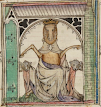But this time of year really is perfect for kimono wearing, so hopefully we'll have more learning adventures in kitsuke to discuss.
I said I've sworn off buying kimono, but...
I have a large tax return coming my way, and I've been scheming about how to divvy it up. I thought it might be a good chance to get a rarer, nicer kimono item. I saw an obi today at Ichiroya that I really, really liked, but reined in my mousing finger... which worked out for the best, because browsing the catalog dug up this old Taisho kimono that I've been checking out for ages. Nice obi come and go, but a kimono like this that's wearable, in good condition, and affordable only comes along so often. Now it is mine!
That's actually a relatively informal kimono. Standard "out and about in public" clothes. The pattern is just striped/banded, but you can see that the blue bands also have a yabane (arrow) pattern.
Taisho is the period from 1912-1926. The designs are notable for being bold and bright, but this trend actually extends a little before and after the Taisho period proper [1]. Basically, from the end of the 1800s until WWII, with Taisho being the peak. With the Taisho period came the introduction/popularization of synthetic dyes, which is what allowed for the brighter colors. Of course kimono since then have continued to be bright, but the Taisho design sensibility and color palates are unique. Art Nouveau and Art Deco influence became very evident in some kimono design, and I think you can see it in the flowers on that kimono. (The general consensus is that they're peonies.) Also, these days, brightness is a matter of taste (gentler kimono seem much more popular), whereas in the Taisho period, it seems as if everyone [2] wore bold kimono, because it was such a radically new thing. The jazz age wasn't limited to the west!
This gallery has many splendid examples of Taisho kimono, so you can acquaint yourself with that aesthetic.
Bold and colorful kimono had existed before, but the dye range was more limited, and for probably at least a century before the Taisho period, "iki" had been the height of stylishness. Iki is understated cool. Why wear a bright red kimono when you can wear a simple, navy and grey striped one lined with bright red, so that it will hint at the color as you move? It's a very Japanese concept -- never come out and say it, just suggest it.
Now, to find a matching obi!
--
[1] Naturally. History, of course, doesn't begin and end with dates set according to particular individual's life spans.
[2] Everyone who was anyone, anyway.
